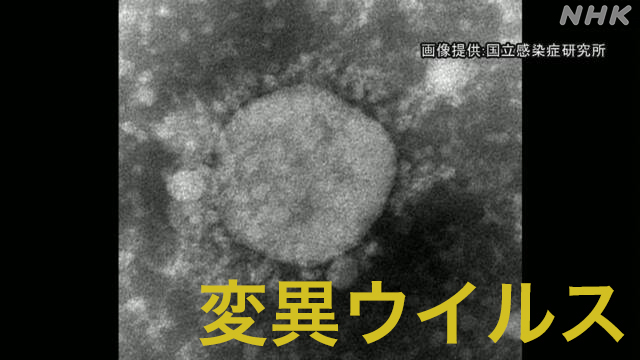The Ministry of Health, Labor and Welfare has announced that 2352 new cases of the mutated coronavirus have been confirmed by local government inspections nationwide in the past week.
New confirmations are 1.5 times higher than the previous week, and the total number of infected people so far is close to 6000.
Municipalities across the country have extracted samples from some of the new coronavirus-infected individuals and are investigating whether they are infected with the mutant virus found in the United Kingdom, Brazil, South Africa, and the Philippines.
According to a summary by the Ministry of Health, Labor and Welfare, the mutant virus was detected in a total of 2352 specimens in 42 prefectures excluding Aomori, Iwate, Yamagata, Fukushima, and Saga prefectures in the week leading up to the 20th. ..
This is about 1.5 times higher than the previous week.
By prefecture, the
largest number was 549 in Tokyo,
followed
by 209 in Osaka
, 196 in Saitama
, 120 in Kanagawa
, 119 in Hokkaido,
and 106 in Ehime.
So far, a total of 5916 people have been confirmed to be infected with the mutant virus by local government inspections.
In addition, the gene for the mutant virus has been confirmed at the National Institute of Infectious Diseases in a total of 1646 people nationwide, and 95% of them are said to have detected the first virus found in the United Kingdom. That is.
This mutant virus is said to be more infectious than conventional ones, and the Ministry of Health, Labor and Welfare and local governments are strengthening the monitoring system.
The proportion of children is ...
It has been pointed out that mutant viruses are more infectious than conventional viruses and may be more susceptible to infection in all age groups, but it is not yet known in detail whether children are susceptible to infection. Hmm.
The National Institute of Infectious Diseases is conducting an epidemiological analysis of infected individuals in Japan as of the 5th of this month.
According to the results, 1889 people infected with the first confirmed type of mutant virus in the United Kingdom and 35,216 people infected with the conventional virus were analyzed by age, and the conventional virus was infected from 0 to 5 years old or younger. The number of people was 2.1% of the total, while that of mutant viruses increased to 4.3%.
In addition, for infected persons aged 6 to 17 years old, which is the school age, 5.7% of the total was for the conventional virus, but 10.3% for the mutant virus, which also increased.
In other age groups, the proportion of infected people aged 65 and over was low due to the mutant virus, but there was no significant change.
The high proportion of children at the National Institute of Infectious Diseases may be influenced by the fact that a cluster of infected people was found in facilities related to children at the beginning of the outbreak of the mutant virus. There is.
Furthermore, according to the data presented by the Ministry of Health, Labor and Welfare at an expert meeting on the 20th, as of 19th of this month, 1477 people who were confirmed to be infected with the mutant virus by detailed genetic testing were analyzed by age group, and as a result, the conventional virus was under 10 years old. Compared to 3%, 8% for mutant viruses and 7% for teens was 11% for mutant viruses, increasing the proportion of teens and younger.
However, the proportion of people under the age of teenagers is lower than it was a month ago, and the expert meeting says that there is no clear tendency for infection to spread under the age of 15 at this stage.
In a week until the 20th ...
The prefectures and the number of prefectures that have been confirmed to be infected with the mutant virus by local government inspections during the week up to the 20th are as follows.
According to a summary by the Ministry of Health, Labor and Welfare
, the
largest number
was 549 in Tokyo,
followed
by 209 in Osaka
, 196 in Saitama
, 120 in Kanagawa
, 119 in Hokkaido, and
▽ in Ehime. 106 people,
▽ 91 people in Kyoto prefecture,
▽ 85 people in Fukuoka prefecture,
▽ 79 people in Shiga prefecture,
▽ 76 people in Hyogo prefecture,
▽ 73 people in Aichi prefecture,
▽ 57 people in Kagawa prefecture,
▽ 55
people in
Toyama prefecture People,
▽ 54 people in Chiba prefecture
,
▽
53 people in Mie prefecture,
▽ 48 people in Nara prefecture,
▽ 43 people in Ibaraki prefecture,
▽ 42 people in Hiroshima prefecture,
▽ 34 people in Okayama prefecture,
▽ 29 people in Gunma prefecture ,
▽ 26 people in Gifu and Tottori prefectures,
▽ 25 people in Yamaguchi prefecture,
▽ 24 people in Miyagi prefecture,
▽ 21 people in Shizuoka prefecture,
▽ 14 people in Tochigi prefecture,
▽ 12 people in Okinawa prefecture,
▽ Akita prefecture 11 in Fukui
, 8 in Niigata and Nagano, 8 in Oita
, 7 in Yamanashi and Kumamoto
, 6 in Wakayama and Miyazaki
, 5 in Ishikawa,
▽ in Nagasaki 4 people,
▽ Two people in Kochi prefecture,
▽ One
person in
Shimane prefecture, Tokushima prefecture, and Kagoshima prefecture.
In Aomori, Iwate, Yamagata, Fukushima, and Saga prefectures, the Ministry of Health, Labor and Welfare
has not confirmed
the summary in the
week leading up to the 20th.
The Ministry of Health, Labor and Welfare collects these data through the system "HER-SYS" that aggregates information on infected persons, and the number may differ from the announcement by the local government.

